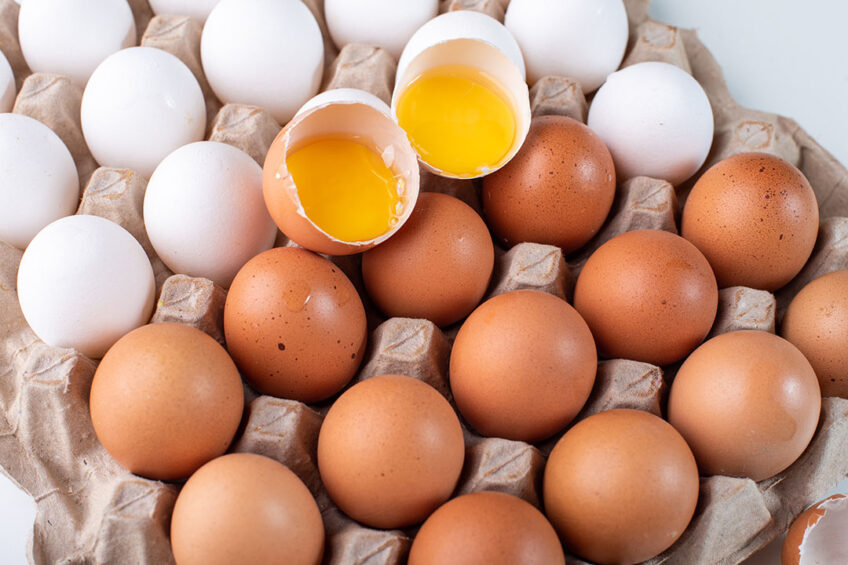The effect of astaxanthin on egg yolk colour, production and animal health

Astaxanthin is an important fat-soluble pigment that naturally occurs in algae, bacteria, and yeast. Dietary supplementation of astaxanthin affects egg yolk indices, egg production, antioxidative status, immune function, metabolism, and fertility.
Considering the increasing global egg consumption, it is important to naturally enrich the yolk without adversely affecting egg production and egg physical properties. Carotenoids are red, orange, and yellow pigments produced by photosynthetic organisms through biosynthesis and widely distributed in fruits, vegetables, fungi, flowers, cells of humans and animals.
Besides improving the yolk colour, supplementing astaxanthin to laying hen diet affects egg yolk indices, egg production, antioxidative status, immune function, metabolism, and fertility.
Source of astaxanthin: Algae, yeasts and bacteria
Natural astaxanthin is directly found in algae, bacteria, and yeast, commercial astaxanthin is mainly produced from algae and yeasts.
- The micro algae Haematococcus pluvialis exhibits a red colour at its mature stage due to accumulated astaxanthin (55 mg/g of dry weight).
- The algae Neochloris wimmeri, Protosiphon botryoides, and Scotiellopsis oocystiformis contain high amounts of astaxanthin (15 mg/g of dry weight).
- The yeast Phaffia rhodozyma have the astaxanthin production capacity of up to 6.4 mg/g of dry weight.
- Bacteria such as Escherichia coli has a maximum astaxanthin quantity of 6.2 mg/g of dry weight.
What is the effect of astaxanthin on egg yolk indices?
Yolk colour is an important sensory index for consumers. The evaluation of the egg yolk pigmentation is performed by examining the appearance, the yolk colour fan score, lightness, red, and yellow values of the egg yolk. Supplementing astaxanthin in the laying hen diet increases the red colour of the egg yolk and the astaxanthin content, satisfies the consumer preference for the yolk colour, but has no negative effects on other indicators.
Diet containing microalgal Haematococcus pluvialis, astaxanthin-rich corn, Paracoccus carotinifaciens, Phaffia rhodozyma and marine byproducts, especially cooked shrimp head significantly increases the astaxanthin content in the egg yolk. Astaxanthin supplementation affects the metabolism of lipids and fatty acids, reduces the content of palmitoleic acid by increasing the proportion of heptadecenoic acid, and decreases the proportion of polyunsaturated fatty acids in the egg yolk.
What is the effect of astaxanthin on egg production?
There are inconsistent effects of astaxanthin and its source products on the production performance of laying hens. Dietary supplementation of Phaffia rhodozyma increases feed intake and egg production but has no effect on egg weight and egg mass. Paracoccus marcusii-sourced astaxanthin increases egg production but has no effect on the body weight of hens. Marine byproducts such as scallop viscera, squid viscera, and shrimp head enhance egg laying rate, egg mass, and feed conversion ratio.
What is the effect of astaxanthin on animal health?
Antioxidative status
Astaxanthin is a stronger antioxidant compared to β-carotene, vitamin E, and vitamin C. Astaxanthin has a strong singlet oxygen quenching capacity, reduces the level of reactive oxygen species, and suppresses lipid peroxidation. Astaxanthin increases the activities of superoxide dismutase, catalase, and glutathione peroxidase, but decreases malonaldehyde in the plasma, liver, and egg yolk. Free astaxanthin combined with oxygen radicals prevents oxidation of free docosahexaenoic acid and improves the storage stability of docosahexaenoic acid-enriched eggs at 4 °C.
Immune function
Astaxanthin promotes immune mediator secretion, protects immune cells, inhibits inflammatory responses, and increases serum IgG level. Dietary astaxanthin can break through the productive barrier into the egg yolk and permeate through the blood-brain barrier to exert neuroprotective benefits and to modulate immune response through the nervous system. Astaxanthin has an anti-inflammatory effect on neurological diseases, gastrointestinal diseases, hepatic and renal diseases, and eye and skin disorders, and decreases serum pro-inflammatory factors and anti-inflammatory cytokine.
Metabolism and fertility
The use of astaxanthin in the diet increases serum glucose, phosphorus, and calcium, and reduces serum cholesterol, alanine aminotransferase, aspartate aminotransferase, and alkaline phosphatase. Astaxanthin increases HDL and VLDL, but decreases hematologic triglyceride, cholesterol, LDL, and hepatic polyunsaturated fatty acids. Adding astaxanthin to the feed of laying hen improves the percentages of egg fertilisation, hatchability, and healthy chicks and it also protects the semen quality of breeder roosters.
Concluding remarks
Astaxanthin is an abundant pigment in algae, bacteria, and yeast and the main source of egg yolk colour. Dietary supplementation of astaxanthin affects egg yolk indices, egg production, antioxidative status, immune function, metabolism, and fertility. However, further research is required to focus on the relationships among astaxanthin sources, dietary concentrations, deposition rates, and hen species.











